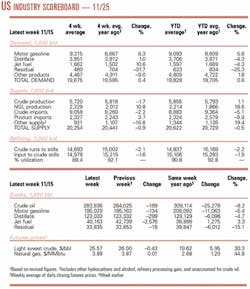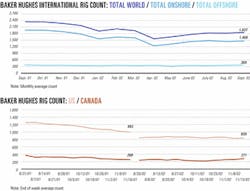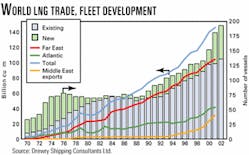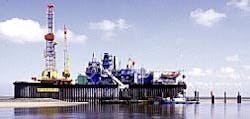Market Movement
Natural gas market tightens
Continued drops in US natural gas production and drilling, plus earlier draws of gas from storage because of colder fall weather, quickly will tighten market fundamentals, said Stephen Smith, president and founder of Stephen Smith Energy Associates, Natchez, Miss.
"Events of recent weeks have provided further encouragement that the trend decline in US production should restore gas market balance in 2003, possibly as early as the first quarter with the occurrence of normal weather," said Smith, a former analyst with Dain Rauscher Wessels Inc. in Houston.
"This surplus began 2002 at 540 bcf over the weekly norm and peaked at over 700 bcf (in the first quarter)," he said.
But then back-to-back storms disrupted 90 bcf of Gulf of Mexico gas production, and 2 weeks of cold weather triggered early draws of gas from storage.
"The gas surplus has almost vanished," Smith said. "(US) weather has turned milder since Nov. 8, so there could be some modest increases in the surplus if milder fall weather continues." Still, he said, "Our basic conclusion (of tightening markets) remains the same."
Smith had projected a draw of 63 bcf of gas from US underground storage during the week ended Nov. 8, but the US Energy Information Administration reported a draw of 48 bcf (see table). "Our weekly gas demand model is based on daily heating and cooling degree days, so as to properly align those measures with the weekly gas storage reporting period," he said. "At this stage, it is a preliminary model, and it will need some additional testing."
Smith told OGJ, "One problem is that I am adjusting the model coefficients slightly from week to week. The reason for this is that looking too far back to develop your model tends to give too much importance to periods when the capacity to meet swing power loads with gas was much more limited than it is now."
Last week, Smith projected an addition of 27 bcf into storage for the week ended Nov. 15. However, analysts at Enerfax Daily advised, "Look for the EIA to report a storage withdrawal of about 10-20 bcf...compared with 33 bcf injected a year ago and a 5-year average withdrawal of 29 bcf, based on EIA-adjusted figures."
EIA reported Nov. 21 a net decline of 1 bcf to less than 3.1 tcf of gas in storage. US gas storage is down 124 bcf from year-ago levels but up 98 bcf from the 5-year average.
Oil market again jittery
Meanwhile, a relapse of Middle Eastern war nerves among traders triggered a Nov. 18 jump in oil futures prices in New York and London markets, even as the lead team of UN inspectors arrived in Iraq to prepare for the Dec. 23 initiation of the inspection program (OGJ Online, Nov. 18, 2002).
Oil futures prices had fallen the previous week amid market expectations that Iraq's acceptance of the United Nations Security Council's new resolution on the return of weapons inspectors to that country had at least postponed for many months the threat of armed conflict in the Middle East. But continued skepticism among members of President George W. Bush's ad- ministration apparently rattled traders. Some administration members said Iraq might have already violated the UN resolution by firing on allied warplanes patrolling a "no-fly" zone in the north.
Oil futures prices slipped during market adjustments in the following session, but rallied again in midweek trading. As of Nov. 20, the December contract for benchmark US light, sweet crudes was up $1.97 over 3 days of trading to $26.98/bbl, with the January position showing a similar increase of $1.38 to $26.09/bbl on the New York Mercantile Exchange. In London, North Sea Brent oil was up $1.18 to $24.53/bbl during the same period.
Industry Scoreboard
null
null
null
Industry Trends
THE LNG shipping business has seen an unprecedented boom in the past 30 months, while other sectors of the shipping industry are suffering. That word comes from an annual LNG shipping market review and forecast issued by Drewry Shipping Consultants Ltd., London. The report notes accelerated ordering activity for new vessels along with escalating interest in new supply projects as well as new and expanded terminals.
With a growing fleet and more trading opportunities, the traditional structure of LNG shipping deals could become more flexible in the future, with more spot and short-term contracts, Drewry said. New technologies are lowering LNG costs and making previously uneconomic projects viable. For example, in ship design, new propulsion systems aim to replace traditional steam turbine engines with smaller, more-efficient units that will reduce fuel costs and increase cargo carrying capacity.
Orders for new LNG ships include several requests for onboard regasification facilities. These ships will open up new areas to the possibility of LNG imports and help overcome environmental objections to new LNG receiving terminals, Drewry said.
It's been widely forecast that LNG trading volumes will grow 7-8%/year for the next decade, Drewry said (see chart).
Short-term problems could emerge in middecade with new shipping capacity becoming available faster than LNG liquefaction or regasification capacity. The worldwide fleet is expected to expand to 193 vessels by 2006, Drewry said.
CANADIAN NATURAL GAS reserves climbed during 2001, estimates the Canadian Association of Petroleum Producers (CAPP).
"Last year, the focus of the conventional sector was towards natural gas, and that is reflected by new additions of gas reserves," said John Dielwart, chairman of CAPP's board of governors, adding, "New reserves added 106% of gas production. This is an increase over last year's 79% replacement rate."
Meanwhile, Canadian reserves of crude oil and equivalent, which includes oil sands, declined by 366 million bbl to 11.9 billion bbl, CAPP reported. "This is indicative of the oil-gas drilling ratio in 2001," CAPP said, adding that oil accounted for 27% of all the successful wells drilled in Canada last year.
"Last year, we invested close to $28 billion in Canada—in the conventional areas of the Western (Canadaian) Sedimentary Basin, northern Canada, in the oil sands, and on the East Coast—making the oil and natural gas industry the largest private sector investor in Canada," Dielwart said.
Government Developments
THE US STRATEGIC PETROLEUM RESERVE holds the largest volume of crude stored ever since the federal government began the emergency stockpile in 1977.
US Department of Energy officials say the SPR now holds 592 million bbl of oil, and it is expected to reach the design capacity of 700 million bbl in 2005.
"At a time when America's energy security is one of our highest national priorities, this milestone is especially timely," said Sec. of Energy Spencer Abraham. "Every barrel of oil in the Strategic Petroleum Reserve provides added energy insurance that helps protect Americans against emergency oil disruptions. That is why the president has committed to filling the reserve to its full 700 million bbl capacity."
Currently, about 100,000 b/d of oil produced from federal offshore leases is swapped for oil that meets SPR quality specifications. US officials predict that royalty-in-kind oil volumes dedicated to the SPR will increase to 130,000 b/d in 2003 (OGJ Online, Oct. 9, 2002).
PERU'S STATE OIL AGENCY Perupetro has decided to keep Block 56, adjacent to the Camisea natural gas fields, until the proposed Camisea LNG or gas-to-liquids export project materializes.
Block 56 has estimated reserves of 3 tcf of gas in Pagoreni and Mipaya fields. Last year, Perupetro said it would auction concessions for Blocks 56, 57, and 58—all adjacent to the Camisea fields. But companies that had shown earlier interest have since backed out, and Perupetro decided that the main Camisea fields, with an estimated 11 tcf of gas reserves, are sufficient to fulfill immediate gas demands (see related stories, pp. 20, 22).
Companies that previously indicated an interest in Block 56 included TotalFinaElf SA, Repsol-YPF SA, Occidental Petroleum Corp., and Hunt Oil Co. (OGJ Online, July 16, 2002).
PERU'S BLOCK 64 also is in the news.
Occidental Exploradora del Peru Inc. is holding public hearings this month on an environmental impact assessment (EIA) of its proposed exploration program on Block 64 in Marañon basin.
The block has been in force majeure since October 1996, when indigenous communities rejected oil companies working in their areas.
The EIA covers plans to conduct a seismic survey, drill an exploratory well and drill one possible confirmation well in the northwest corner of the block. The hearings are being held at the Amazon National University postgraduate school in Iquitos, the town of San Lorenzo, and indigenous communities in the project's area. The company has published announcements in the towns and talked with the communities.
Occidental has been holding talks and workshops with the communities since the beginning of the year. Occidental is the operator with a 50% interest in Block 64, with 50% held jointly by its partners Burlington Resources Inc., Houston, and Spain's Repsol-YPF SA.
The Argentine-UK environmental company ERM Peru completed the EIA.
Quick Takes
FRANCE and other European Union countries are assisting Spain in efforts to contain and clean up 4,000-6,000 tonnes of heavy fuel oil spilled off Galicia, Spain, by the stricken Prestige tanker. The vessel split in half Nov.19 and sank in 3,500 m of water 270 km off northwestern Spain where it had been towed after it was severely damaged in a storm near the coast Nov. 13. When it sank, it still contained 73,000 tonnes of heavy fuel oil.
Recovering the oil in such deep water is not considered feasible, experts say.
Some specialists claim the oil could remain on the ocean bottom for some time before spreading toward the coastlines of Spain, Portugal, and France.
The World Wildlife Fund said Galicia could face perhaps the worst tanker oil spill in history, twice the magnitude of the Exxon Valdez spill off Alaska in 1989.
Prior to sinking, the vessel's leaked oil spread over the Galician coastline between Cape Finisterre and Seixo Branco, a major fishing zone. Spanish authorities banned commercial fishing and shell gathering in that area and approved a plan Nov. 18 to pay 1,000 fishermen until they can return to work.
The Prestige was reported bound for Singapore from Riga, Latvia, for Crown Resources AG, a consortium member of the Alpha Group based in Gibraltar. Officials indicated the tanker was owned by Liberia-based Mare Shipping Inc. and was operated by Universal Marine Ltd., also a Liberian company. The entire crew, which was primarily Filipino, was rescued.
Built in 1976 in Japan, the single-hull Prestige was one of the oldest tankers in service.
RWE DEA AG, which operates and holds a 50% interest in Mittelplate oil field in the German sector of the North Sea, has revised the field's estimated reserves to more than 60 million tonnes from 35 million tonnes, based on a recently completed 3D seismic survey and from 15 years of field operation, a spokesman said. Wintershall AG holds an equal interest in the field.
RWE DEA developed the field in tidal waters with an artificial drilling and production island, and 15 wells have been drilled and more than 7 million tonnes of crude produced. Planning is under way to increase production capacity. A pipeline has been proposed to link the Mittelplate drilling and production island to a processing plant at Dieksand land station at Friedrichskoog.
The proposed pipeline would allow production to be increased to 1.4 million tonnes/year from 800,000 tonnes/year, RWE DEA said.
RWE DEA is applying for permission to lay the planned pipeline connection, which it expects to be finished by mid-2003, Harald Graser, general manager of corporate communications, told OGJ. "After getting the necessary permits, we plan to establish the pipeline connection during May and June 2004," he said.
Petroleos Brasileiro SA (Petrobras) has started early production from its biggest discovery since 1996. Jubarte field came on stream following the start of a long-term test of its 3-ESS-110H well. The field lies in 1,300 m of water on Block BC-60 in the northern Campos basin, about 70 km off Espírito Santo state. Oil reserves are estimated at 600 million bbl of 17° gravity crude oil. Test simulations indicate the well has the potential to produce 25,000 b/d of crude. Production is being increased gradually. The testing phase is being carried out as scheduled with production reaching 16,500 b/d of oil and 100,000 cu m/day of natural gas. The oil is being produced into storage on the Seillean floating production, storage, and offloading vessel. From there, it will be lightered by shuttle tanker to Petrobras terminals and refineries onshore, said Petrobras. To date, the company has spent $100 million on the project.
DEEPWATER PROJECTS dominate development news this week.
The US Minerals Management Service approved on Nov. 7 the first permanent use of synthetic moorings to anchor a platform to the seabed in deep water. The action came during a preliminary review of BP PLC's deepwater operations plan for the development of Mad Dog field in the Gulf of Mexico. Project owners are BP 63.56%, Unocal Corp. 25%, and BHP Petroleum (Americas) Inc. 11.44%.
Mad Dog's reserves are estimated at 400 million boe, and the field is on a $1 billion fast-track development schedule to produce first oil at yearend 2004 (OGJ, June 17, 2002, p. 22). BP will install a truss spar employing dry tree wells and the first permanent use in the gulf of high-strength polyester synthetic moorings that will provide protection equal to or greater than that provided by steel wire rope systems while reducing the vertical loads on the spar hull, MMS said. The truss spar will be held on location by an 11-line polyester taut-leg mooring configuration. The field lies on Green Canyon Block 826 in 4,420 ft of water.
Kerr-McGee Oil & Gas Corp., a unit of Oklahoma City-based Kerr-McGee Corp., has awarded a contract for the supply of flexible flowline, jumper, and risers for Gunnison field's spar development project in the Gulf of Mexico to Wellstream, a unit of Halliburton Energy Services Group. Wellstream will deliver in June a 5.375-in. ID, 8,000 psi flowline; a 5.375-in. ID, 8,000 psi jumper; and three 5.375-in. ID, 8,000 psi risers. Gunnison field lies in almost 3,150 ft of water on Garden Banks Block 668 about 155 miles southeast of Galveston, Tex. (OGJ Online, June 5, 2000).
The field will be developed using the Kerr-McGee Global Producer VII truss spar, designed to produce 40,000 b/d of oil and 200 MMcfd of natural gas. First oil is anticipated in first quarter 2004.
BRAZIL'S NATIONAL PETROLEUM AGENCY (ANP) scheduled its fifth licensing round for oil and natural gas exploration and production for next June. Employing a new bidding method, ANP will divide sedimentary basins into sectors and subdivide them into cells that can be offered individually or in groups, depending on geographical locations on land or in shallow or deep waters.
Bids will be accepted simultaneously from interested companies for all areas not already under concession. Round 5 will offer 1,122 exploration cells—824 offshore and 298 onshore—in 21 sectors of 9 sedimentary basins located in or off 10 states.
Cells will be offered in three sizes for different locations:
- Onshore, 30-32 sq km, the size of a single cell.
- In shallow waters of less than 400 m, 171-192 sq km, which equals 6 cells.
- In deeper waters to 2,000 m, 646-768 sq km, the equivalent of 24 cells.
The area of cells to be offered in Round 5 totals 195,701.54 sq km, which corresponds to 3% of the total area of Brazil's sedimentary basins.
Canada's Niko Resources Ltd. has discovered natural gas in two of three exploratory wells on its 419 sq km CB-ONN-2000/2 onshore block near Surat, Gujarat, India. "The flow rate from Bheema-I, the second well, totaled 16 MMcfd of sweet dry gas," said an Indian oil ministry official. Niko plans to drill seven more wells on the block during the current fiscal year, he said. The Canadian company holds 100% interest in the Surat block. The first of a 15-well onshore exploration and appraisal program got under way on Apr. 16, targeting Miocene reservoir sands analogous to those currently producing at Niko's 1 tcf Hazira gas field, 20 km to the southwest. Under terms of its production-sharing contract, the company is required to drill 15 wells and shoot 250 sq km of 3D seismic over 2 years. A second 2-year commitment, dependent on the results of the first phase, requires the drilling of five wells and the shooting of an additional 50 sq km of 3D seismic. The company is required to return a portion of the block at the end of each commitment phase.
Talisman Energy Inc. signed an exploration and production-sharing agreement (PSA) with the Qatar government for Block 10 covering 784,000 acres in shallow water 100 km northeast of Doha. The block lies between Al Khalij oil field to the east and Al Shaheen oil field and North gas field to the west. The first exploration term is for 5 years, during which time Talisman said it would reprocess existing 2D seismic data, acquire new 2D and 3D seismic data, and drill three wildcat wells. x‡ The Georgian State Agency for Regulation of Oil and Gas Resources awarded CanArgo Norio Ltd., a unit of London-based CanArgo Energy Corp., the oil and gas exploration and production rights to Block XI(G) (Tbilisi) and Block XI(H) (Rustavi) in eastern Georgia, pending negotiations of a PSA. The blocks cover 486 sq km and abut CanArgo's existing acreage. CanArgo also reached an agreement with the other shareholders in CanArgo Norio to increase its interest to 65% from 50% and is eeking a partner to help complete the Norio MK72 exploration well on Nario block near Samgori field. The well has been suspended at a depth of 2,932 m. Target depth is 4,200 m.
Kinder Morgan Energy Partners LP and Pemex Gas y Petroquimica Basica (PGPB) have begun construction on Kinder Morgan's new $87 million, Mier-Monterrey natural gas pipeline from South Texas to Monterrey, Mexico—one of that country's fastest growing industrial areas.
The 95 mile pipeline, designed to transport as much as 375 MMcfd of gas initially, will interconnect with the southern end of the Kinder Morgan Texas Pipeline system in Starr County, Tex. PGPB has subscribed for all of the capacity under a 15-year contract with Kinder Morgan.
The pipeline will connect to the PGPB gas transportation system and to a 1,000 Mw power plant complex owned by Iberdrola SA and Comision Federal de Electricidad, the national electric power entity.
Pipeline construction is scheduled for completion during second quarter 2003.
INVESTIGATIONS are under way to determine the cause of a Nov. 16 explosion and fire at a development well being drilled at Tapia Canyon heavy oil field in northern Los Angeles County.
The blast killed one worker and seriously injured another. Both victims were employees of Caza Drilling Inc., Denver, which at the time of the explosion was drilling on behalf of Denver-based operator TEG Oil & Gas USA Inc., a subsidiary of Sefton Resources Inc., also based in Denver.
Houston-based Boots & Coots International Well Control Service controlled the flow with a temporary cap on the well, and extinguished the fire by Nov. 19.
The well control company then installed a permanent cap on the well the same evening, following debris removal.
The cause of the accident was undetermined at presstime, but Sefton Chairman and CEO Jim Ellerton said the driller had "reached its target drilling depth of 1,285 ft and was bringing the drill string out of hole when the well blew out, apparently from a shallow gas zoneUThe (heavy) oil stayed in the hole. Dry gas and sand came up, but it was clean sand, and there was no sulfur and no environmental damage," he said.
Tengizchevroil (TCO), headed by ChevronTexaco Corp., has instructed Parker Drilling Co. to suspend drilling operations upon completion of wells currently being drilled in Kazakhstan's Tengiz field. On Nov. 15, ChevronTexaco reported that TCO had suspended the planned expansion of the second-generation production and sour gas injection projects because project partners had not agreed on a funding plan.
"The TCO partners failed to sanction the projects moving to the next stage in our capital management process, and therefore we had no option but to suspend all activity at this time," said Peter Robertson, ChevronTexaco vice-chairman. The sour gas injection plant would have reduced the sulfur content of oil shipped from Tengiz.
However, he said ChevronTexaco continues to work with its partners to reach a mutually agreeable solution. Tengiz field has been averaging output of 260,000 b/d of oil in recent months and has the potential to yield 700,000 b/d by 2010. Its production was expected to nearly double by 2006 (OGJ Online, Aug. 5, 2002).







